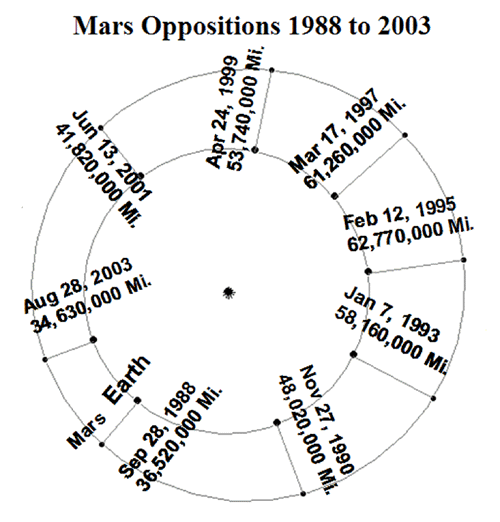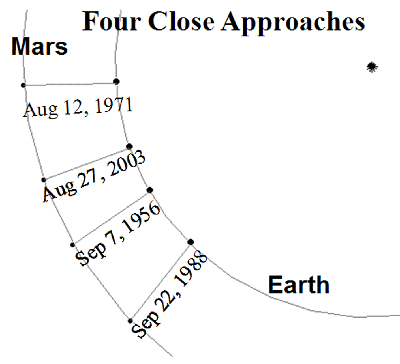Ghosts of Oppositions Past
© 2003 by Robert C. Moler
 The
times when Mars comes closest to the earth is when it is near
opposite the sun in the sky, or simply stated: at opposition. Mars
passes opposition about every two years and two months on average.
That is called its synodic period, the time it takes Mars to orbit
our sky with respect to the sun. Mars actual orbit of the sun takes
687 days or 1 year 10 and a half months. Therefore each time we pass
Mars, we are a bit farther along its orbit. This is a big deal with
Mars, because its orbit is quite elliptical. The distance of Mars at
opposition can vary from less than 35 million miles to over 62
million.
The
times when Mars comes closest to the earth is when it is near
opposite the sun in the sky, or simply stated: at opposition. Mars
passes opposition about every two years and two months on average.
That is called its synodic period, the time it takes Mars to orbit
our sky with respect to the sun. Mars actual orbit of the sun takes
687 days or 1 year 10 and a half months. Therefore each time we pass
Mars, we are a bit farther along its orbit. This is a big deal with
Mars, because its orbit is quite elliptical. The distance of Mars at
opposition can vary from less than 35 million miles to over 62
million.
Close oppositions are the best chance earth-bound
observers have of viewing this most intriguing of planets. Mars is a
bit larger than half the size of the earth. At its closest Mars will
appear a bit larger than 25 seconds or arc (”) in diameter. A
second of arc is 1/3600th of a degree. In contrast Jupiter, a far
larger but distant planet never appears smaller than 30” in
diameter, and appears 45” in diameter at its closest.
The diagram above shows the oppositions for the past 15
years, from the last close opposition in 1998 through to the one this
year. The opposition distances vary by a factor of 1.8 from the
closest in 2003 to the farthest in 1995. As a rule of thumb, close
oppositions occur every 15 or 17 years. The interval from 1988 to
2003 is the lower value of 15 years.
 The
4 close oppositions of my lifetime were 1956, 1971, 1988, and
hopefully will be 2003. Their intervals are 15, 17 and 15 years
respectively. As can be seen on the chart on the next page, the
actual distances vary a bit, depending on the position of Mars at
opposition versus the perihelion point. Actually the 1973 opposition
was nearly as close as the 1971 one. It was the 1973 opposition that
I made an intense study of the planet using a 6’ telescope.
The
4 close oppositions of my lifetime were 1956, 1971, 1988, and
hopefully will be 2003. Their intervals are 15, 17 and 15 years
respectively. As can be seen on the chart on the next page, the
actual distances vary a bit, depending on the position of Mars at
opposition versus the perihelion point. Actually the 1973 opposition
was nearly as close as the 1971 one. It was the 1973 opposition that
I made an intense study of the planet using a 6’ telescope.
Our understanding of Mars has undergone a revolution
since the 1956 opposition. We have learned more about Mars since
1956 than the period between the invention of the telescope and 1956.
In 1956 the idea that Mars had thin lines called canals
on its surface still caught the public’s imagination.
Astronomers were divided about them. Even though some astronomers
saw then visually at the eyepiece, no photograph ever revealed them.
The photographs confirmed visual sighting of the polar caps which
grew bigger and smaller with the Martian seasons, and the dark area
markings on the planet. What the markings were was anybody’s
guess. Was it vegetation? The coloration was reported to change as
spring arrived. Of course Mars is mostly red. It’s reddish
hue, suggestive of blood to the Greeks and Romans, caused the planet
to be named in honor of the god of war.
The orbit of Mars, its size, rotation, carbon dioxide
atmosphere, two satellites, and the thought that the red color was
caused by good old rust were some of the few things we got right by
1956.
I remember the intense media and astronomical attention
to Mars in 1956. It was the closest opposition since 1924. I turned
my new 5” telescope to Mars and saw very little. The southern
polar cap was visible and I was able to see the large dark triangular
area Syrtis Major. When Mars is at the most favorable oppositions it
is summer in the southern hemisphere, so the Martian south pole is
tilted toward the sun, and the earth.
Between the oppositions of 1956 and 1971 the study of
Mars underwent a revolution. In 1956 observations of Mars or any
other celestial object was done from inside the earth’s
atmosphere. In 1957 the first earth orbital satellite was launched.
This came a flood of robotic missions to the moon, Venus and Mars.
Mars was visited by flyby missions of Mariner 4 in 1965, and Mariners
6 and 7 in 1969, which were eclipsed by the triumph of the first
manned landing on the moon a few weeks earlier.
These early Mariners gave us a quick glimpse of the
southern hemisphere of Mars and showed a cratered, moonlike
landscape. As mars passed its close opposition of 1971 a small craft
was on its way. Mariner 9 entered orbit of Mars and settled down to
wait. It was a good thing too because Mars was enveloped in a
planet-wide dust storm. A Russian lander crashed in the raging dust
storm that year. That’s one thing that Martian southern
summers produce, and can spoil views of a close opposition. Mariner
9, then the Viking 1 and 2 orbiters added a quantum leap in our
knowledge of the Red Planet. It turns out that Mars isn’t like
the moon, or the earth for that matter. Mars is, well, like Mars.
It is its own unique planet.
The close opposition of 1988 was the first for the GTAS
and the Rogers observatory. We had a lot of visitors straining to
see features on that tiny orb.
Since then Mars has received more missions fron earth.
After several failures, both American and Russian, the Mars
Pathfinder lander bounced down on the Martian surface July 4, 1997.
Soon after the Sojourner rover drove out on the red sands of Mars.
The Mars Global Explorer entered orbit of Mars a few months later,
and continues to this day sending back a wealth of photos. It was
joined in 2001 by the Mars Odyssey orbiter.
This year’s close approach of Mars is the closest
since the dawn of recorded history, giving earthbound observers like
us a chance once again to wonder as we watch that wiggling red orb
from the bottom of our sea of atmosphere.
Questions? Send Email to me at bob@bjmoler.org
Updated: 6/12/03
 The
times when Mars comes closest to the earth is when it is near
opposite the sun in the sky, or simply stated: at opposition. Mars
passes opposition about every two years and two months on average.
That is called its synodic period, the time it takes Mars to orbit
our sky with respect to the sun. Mars actual orbit of the sun takes
687 days or 1 year 10 and a half months. Therefore each time we pass
Mars, we are a bit farther along its orbit. This is a big deal with
Mars, because its orbit is quite elliptical. The distance of Mars at
opposition can vary from less than 35 million miles to over 62
million.
The
times when Mars comes closest to the earth is when it is near
opposite the sun in the sky, or simply stated: at opposition. Mars
passes opposition about every two years and two months on average.
That is called its synodic period, the time it takes Mars to orbit
our sky with respect to the sun. Mars actual orbit of the sun takes
687 days or 1 year 10 and a half months. Therefore each time we pass
Mars, we are a bit farther along its orbit. This is a big deal with
Mars, because its orbit is quite elliptical. The distance of Mars at
opposition can vary from less than 35 million miles to over 62
million. The
4 close oppositions of my lifetime were 1956, 1971, 1988, and
hopefully will be 2003. Their intervals are 15, 17 and 15 years
respectively. As can be seen on the chart on the next page, the
actual distances vary a bit, depending on the position of Mars at
opposition versus the perihelion point. Actually the 1973 opposition
was nearly as close as the 1971 one. It was the 1973 opposition that
I made an intense study of the planet using a 6’ telescope.
The
4 close oppositions of my lifetime were 1956, 1971, 1988, and
hopefully will be 2003. Their intervals are 15, 17 and 15 years
respectively. As can be seen on the chart on the next page, the
actual distances vary a bit, depending on the position of Mars at
opposition versus the perihelion point. Actually the 1973 opposition
was nearly as close as the 1971 one. It was the 1973 opposition that
I made an intense study of the planet using a 6’ telescope.